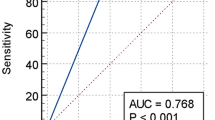Abstract
Objective
Placental growth factor (PlGF) is an angiogenetic factor and inducts the development of preeclampsia in a hypoxic environment. In this study, we examined maternal blood PlGF levels in a pregnant population between 16 and 19 weeks of gestation for determining the prospective value for early diagnosis of preeclampsia as a screening test.
Materials and Methods
In this prospective cross-sectional study, 114 nulliparous normotensive pregnant women were selected for the control group and 34 patients who have chronic hypertension or had a medical history of hypertensive disorders in previous pregnancies were selected for the study group.
Results
In the study group, the risk of preeclampsia increased 3.2 times when compared with the control with a confidence interval of 95 %. The cut-off value for PlGF for discriminating preeclamptic and non-preeclamptic patients was found to be 62.5 pg/ml.
Conclusion
Patients with a medical history of hypertensive disorders and low PIGF levels in early second trimester have an increased risk for preeclampsia.


Similar content being viewed by others
References
Sibai B, Dekker G, Kupferminc M. Pre-eclampsia. Lancet. 2005;365:785–99.
Iyer S, Acharya KR. Role of placenta growth factor in cardiovascular health. Trends Cardiovasc Med. 2002;12:128–34.
Kyle PM, Buckley D, Kissane J, et al. The angiotensin sensitivity test and low-dose aspirin are ineffective methods to predict and prevent hypertensive disorders in nulliparous pregnancy. Am J Obstet Gynecol. 1995;173(3 Pt 1):865–72.
Vuorela P, Hatva E, Lymboussaki A. Expression of vascular endothelial growth factor and placenta growth factor in human placenta. Biol Reprod. 1997;56:489–94.
Kingdom J, Huppertz B, Seaward G. Development of the placental villous tree and its consequences for fetal growth. Eur J Obstet Gynecol Reprod Biol. 2000;92:35–43.
Rajakumar A, Cerdeira AS, Rana S, et al. Transcriptionally active syncytial aggregates in maternal circulation may contribute to circulating soluble fms-like tyrosine kinase 1 in preeclampsia. Hypertension. 2012;59(2):256–64.
Youssef A, Righetti F, Morano D, et al. Uterine artery doppler and biochemical markers (PPAP-A, PlGF, sFlt-1, P-selectin, NGAL) at 11 + 0 and 13 + 6 weeks in the prediction of late (>34 weeks) pre-eclampsia. Prenat Diagn. 2011;31(12):1141–6.
Soto E, Romero R, Kusanovic JP, et al. Late-onset preeclampsia is associated with an imbalance of angiogenic and anti-angiogenic factors in patients with and without placental lesions consistent with maternal underperfusion. J Matern Fetal Neonatal Med. 2011;25(5):498–507.
Torry DS, Wang HS, Wang TH, et al. Preeclampsia is associated with reduced serum levels of placenta growth factor. Am J Obstet Gynecol. 1998;179(6 Pt 1):1539–44.
Maynard SE, Min JY, Merchan J, et al. Excess placental soluble fms-like tyrosine kinase 1 (sFlt1) may contribute to endothelial dysfunction, hypertension, and proteinuria in preeclampsia. J Clin Invest. 2003;111(5):649–58.
Golara M, Benedict A, Jones C, et al. Inflationary oscillometry provides accurate measurement of blood pressure in pre-eclampsia. BJOG. 2002;109:1143–7.
National High Blood Pressure Education Program Working Group. Report of the National High Blood Pressure Education Program Working Group on high blood pressure in pregnancy. Am J Obstet Gynecol. 2000;183:S1–22.
Swets JA. Signal detection theory and ROC analysis in psychology and diagnostics: collected papers. Mahwah: Lawrence Erlbaum Associates; 1996.
Cuckle HS. Screening for pre-eclampsia-lessons from aneuploidy screening. Placenta. 2011;32:42–8.
Tidwell SC, Ho HN, Chiu WH, et al. Low maternal serum levels of placenta growth factor as an antecedent of clinical preeclampsia. Am J Obstet Gynecol. 2001;184(6):1267–72.
Acknowledgments
The authors offer special thanks to Dr. Leyla Mollamahmutoğlu, the head of the Zekai Tahir Burak Women’s Health, Education, and Research Hospital, the Biochemistry laboratory employees, and Dr. Üran Büyükkağnıcı, the laboratory chief.
Conflict of interest
None.
Author information
Authors and Affiliations
Corresponding author
Rights and permissions
About this article
Cite this article
Dover, N., Gulerman, H.C., Celen, S. et al. Placental Growth Factor: As an Early Second Trimester Predictive Marker for Preeclampsia in Normal and High-Risk Pregnancies in a Turkish Population. J Obstet Gynecol India 63, 158–163 (2013). https://doi.org/10.1007/s13224-012-0279-9
Received:
Accepted:
Published:
Issue Date:
DOI: https://doi.org/10.1007/s13224-012-0279-9




